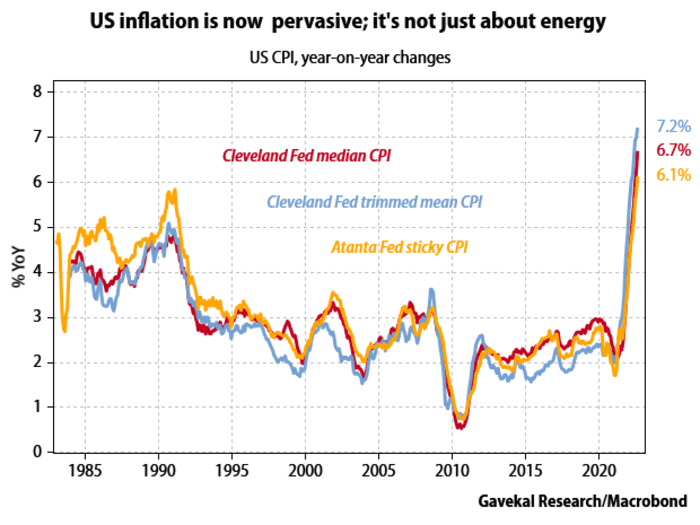Not for the first time, inflation numbers caught the market by surprise. The bad news was the S&P 500
SPX,
saw the largest one-day decline in two years, slumping 4.2%. The good news if you’re checking your 401(k), you’re only back to last week’s levels, and futures are holding up in the early hours of Wednesday.
One month of data is just one month of data, and there are still believers that the Fed in the not too distant future will stop the rate-hike campaign.
“With inflation expectations almost back down to normal levels and broadening disinflationary pressure showing up everywhere except the official CPI, we still expect both headline and core inflation to fall more quickly over the next 12 months than officials currently believe,” said Paul Ashworth, chief U.S. economist at Capital Economics. “The pivot isn’t dead yet.”
But what a rotten month of data it was. The first surprise of the day was that core CPI was much hotter than forecast, and two methods of slicing the numbers by regional Feds contained further bad news. The Atlanta Fed’s sticky-price CPI gauge rose to 6.1% year-over-year from 5.8%. Remember, that’s a weighed basket of items of prices that are meant to change slowly (think, menus). The Cleveland Fed’s median CPI, meanwhile, accelerated to 6.7% from 6.3%.

If you use the old rule of thumb that the Fed has to hike interest rates above the core rate of inflation — and remember, that particular saw is on the Fed’s own website! — then the market is still vastly underestimating how high rates will have to go. Even after Tuesday’s inflation surprise, fed fund futures imply a terminal rate around 4.25%.
Anatole Kaletsky, the chairman and chief economist of Gavekal, calculates that even if price increases come to a complete standstill right now, core inflation would still be 4.3% in December, and the headline rate at 6.2%. If core inflation continues to rise at the 0.56% rate as it did in August, it will hit 6.6% in December — and if inflation rises at the same rate recorded by the median CPI over the last three months, that core number will reach 7.2% by December.
“Many investors expect the U.S. economy to plunge into a deep recession and the Fed to respond by panicking and abandoning its inflation target. Both things may happen eventually, but neither is remotely plausible within the next six months or so,” he says.
After all, the most recent data on U.S. activity actually has been strengthening. “With inflation and labor market reports still pointing clearly to overheating, the Fed will have no excuse to hint at pausing, never mind at future easing,” says Kaletsky.
He forecasts the fed funds rate will be 4.5% by Christmas, that core inflation will be around 6.5% and the U.S. economy will still show no evidence of recession.
“In this case, it is hard to imagine why 10-year bond yields should trade below 4%, and very plausible that the yield curve could disinvert, pushing long-term bond yields towards the 5% mark,” he said. He didn’t offer up a stock market forecast, but suffice to say that if he’s correct about bonds, equities would see more days like Tuesday.
The market
U.S. stock futures
ES00,
NQ00,
were a touch higher. The dollar
DXY,
edged lower, and the yield on the 10-year Treasury
TMUBMUSD10Y,
rose to 3.46%.
The buzz
Producer prices weakened by 0.1% in August, to slow the year-over-year rate to 8.7% from 9.8%.
The U.K. saw inflation come in a touch shy of expectations, falling to 9.9% in August from 10.1%.
The Bank of Japan has conducted a check on the foreign exchange market, the Nikkei newspaper reported, setting the stage for possible intervention to stem the slide in the deteriorating Japanese yen
USDJPY,
Starbucks
SBUX,
unveiled three-year guidance, anticipating it will grow adjusted earnings between 15% and 20% on comparable-store sales growth between 7% and 9%. Starbucks previously forecast 4% to 5% comp sales growth. It said it will return $20 billion to shareholders over the next three years through stock buybacks and dividends.
Alphabet’s
GOOGL,
Google lost most of an appeal over a $4.3 billion fine imposed by the European Union over Android.
The International Energy Agency kept its 2023 oil demand growth forecast unchanged, after lowering China forecasts but lifting those for the rest of the world. The European Union said it will raise some €140 billion from windfall taxes on energy companies.
Best of the web
More on Russia’s frantic retreat from Ukraine.
The good news in the inflation report, for senior citizens, is it will help bump up the cost-of-living adjustment for Social Security, because August is one of the months used to calculate the number.
Barbarians on the blockchain? KKR for the first time is tokenizing a private-equity fund.
Top tickers
Here were the most active stock-market tickers as of 6 a.m. Eastern.
| Ticker | Security name |
| TSLA, | Tesla |
| GME, | GameStop |
| AMC, | AMC Entertainment |
| BBBY, | Bed Bath & Beyond |
| NIO, | Nio |
| AAPL, | Apple |
| APE, | AMC preferred |
| NVDA, | Nvidia |
| AMZN, | Amazon.com |
| ADTX, | Aditxt |
Random reads
Citi
C,
is looking for a new way to recruit junior bankers — having them work from the beach.
Up to 100 employees at the King’s former official residence have been warned they may lose their jobs.
A Virginia man thought he won $600 on the lottery. Actually, it was $1 million.
Need to Know starts early and is updated until the opening bell, but sign up here to get it delivered once to your email box. The emailed version will be sent out at about 7:30 a.m. Eastern.
Source: https://www.marketwatch.com/story/even-after-the-market-meltdown-investors-are-still-making-two-implausible-assumptions-about-the-next-six-months-this-economist-says-11663153079?siteid=yhoof2&yptr=yahoo
